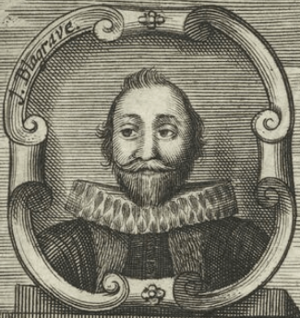John Blagrave facts for kids
Quick facts for kids
John Blagrave
|
|
|---|---|
| Born | Sometime in the 1560s |
| Died | 9 August 1611 Reading, Berkshire
|
| Resting place | St Laurence's Church in Reading, Berkshire |
| Citizenship | English |
| Education | Reading School, St John's College |
| Known for | The Mathematical Jewel |
| Spouse(s) | Dorothy Blagrave (née Gunter) |
| Scientific career | |
| Fields | Mathematics, astronomy, design of instruments |
| Notable students | William Backhouse |
John Blagrave (died 1611) was an English mathematician and astronomer from Reading. He lived during the Tudor period. He was also known for designing special tools for studying the stars and for math. People at the time called him "the flower of mathematicians of his age." His designs for astrolabes were very advanced for Britain.
About John Blagrave
John Blagrave was born in Berkshire sometime in the 1560s. His family was well-known in the area. He went to Reading School and then studied math at St John's College, Oxford. However, he did not finish his degree there.
Blagrave married Dorothy Gunter. He did not have his own children, but he had a stepdaughter named Jane.
He passed away on August 9, 1611, in Southcot Lodge. He was buried next to his mother at St. Laurence's Church in Reading. A large monument was built for him there. It shows a statue of him surrounded by figures related to mathematics. He had asked for this monument in his will.
In his will, Blagrave left land to his nephew. He also gave money to over eighty relatives. He also left a lot of money to help charities.
What John Blagrave Created
Five of Blagrave's works are still known today. He also made a map of the northern hemisphere.
His most famous work is called The Mathematical Jewel. This book describes a very advanced astrolabe that Blagrave designed. An astrolabe is an old tool used to measure the positions of stars and planets. Blagrave's "jewel" had four moving parts. The book showed these parts in great detail.
Blagrave explained that his astrolabe could be used for many things. These included trigonometry, navigation, and even astrology. He wrote that you could find "so infinite a number of conclusions" with it. Some experts think Blagrave's design might have been inspired by an earlier astrolabe from a designer named Ali ibn Khalaf.
Another important book by Blagrave is The art of dyalling. This book is special because it gives one of the earliest descriptions of how to build a sundial. A sundial tells time by using the sun's shadow.
Blagrave was also interested in astrology. His books often mentioned how his tools could be used for astrological purposes. He even taught mathematics to William Backhouse, who was also interested in these subjects.
John Blagrave's Charity Work
John Blagrave was very generous in his will. He left a lot of money to his servants and to poor people in Reading. He also gave a large sum to his local church, St. Laurence's.
One of his most interesting gifts was a special lottery. This lottery gave money every year to an unmarried maidservant in Reading. Blagrave set up funds for this in his will. The lottery continued until the 1800s.
Here's how it worked: Three maidservants were chosen from the three parishes of Reading. They had to be of good character and have worked for the same employer for five years. The lottery was held on Good Friday at the town hall. One of the women would be chosen by luck to receive the money. The other two women could try again the next year.


